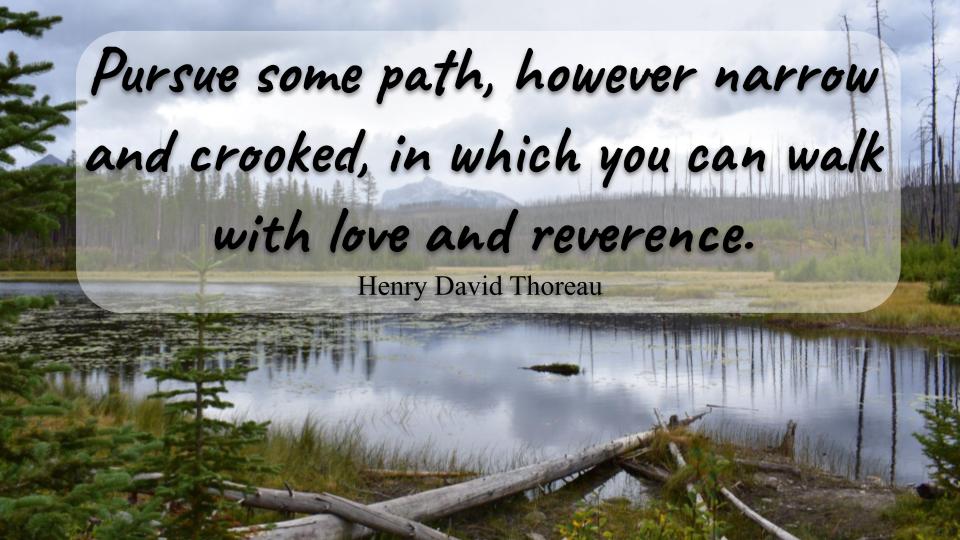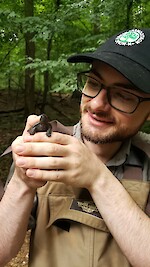Poetry and Progress: Connecting Emotion to the Environment
Barry Bowman · | MEES 620 Fall 2021 | 7 commentsFor our first discussion, we shared how the academic writing style we have been drilling all through college falls short of capturing the hearts and minds of readers as Thoreau’s Walden, Carson’s Silent Spring, and Leopold’s A Sand County Almanac have done. We pursue our scientific fields because we have a thirst for knowledge and a desire to understand the world around us. These pursuits often culminate in published papers and presentations at conferences, but is academia the only audience we should prepare for?
I believe that there are three main audiences we should endeavor to write for. The first would of course be to write for the purpose of publishing research to a peer-reviewed journal, as establishing credibility supports our standing as a qualified expert. The second would be to write for the public. We are well practiced at assimilating information and transforming it for academic purposes, but we can use that same skill and translate the language of science into everyday terms. Furthermore, and thirdly, we can write for ourselves and put the passion we have for our fields behind our words. The results of such writing can be observed from the public's reaction to printed literature, testimony, and social media.
Social pressures have brought about many positive changes for conservation and the environment. The release of Silent Spring galvanized people in support of new legislation that would protect the wellbeing of the national symbol, the bald eagle. Through her published books, Rachel Carson became a generational symbol for the conservation movement; however, without conducting the research she published, Carson would not have been able to share her experience with the general population.

She was able to reach the public, not by publishing to a scientific journal, but by putting herself into her writing. With advances in communication technology and widespread use of the Internet, accessing the public is no more than a button-press away. Furthermore, by making themself available publicly, a scientist can improve the public trust in science through direct interactions. Resources have been put together to help scientists learn how to use these tools. Even this blog is a form of scientific outreach in the Age of the Internet! Whether the conversation is about a public issue or sharing pictures of your favorite [insert organism] of choice, sharing what drives you, your passion, can show others why what you do is important.

Social media can be a powerful tool for influencing change through awareness and public opinion. For example, various corporations and municipalities have banned plastic straws after a viral video of a suffering sea turtle. The scientist responsible for sharing this video wasn’t a tenured expert, but rather a grad student sharing her passion with the public through social media. As public interest grew, so did her involvement with the public (Figgener, 2018). The attention may not have been about her research directly, but the public became interested in the issue of plastic pollution, which is still something she is passionate about.
The drawback of social media also stems from its ease of access. As we have seen from the variety of public responses to the COVID-19 pandemic, misinformation can lead to confusion and potentially damage the reputation of scientists tied to the issue. For this reason, many scientists distance themselves from being actively involved with social media. Inexperience or being unfamiliar with the platform can also serve as a barrier. Proper conduct and behavior online can be difficult when confronted with dissenting opinions or antagonistic language (McClain & Neeley, 2018). However, social media training materials exist to facilitate more widespread use by scientists. Still, social media is not the only way to communicate for some scientists.
The realm of public policy can also be a platform for scientists to engage with the public. Through working with municipal or regional governments, scientists can use their expertise to advise decision makers. The use of incentivised conservation programs is one such example. On a federal level, programs such as the Environmental Quality Incentives Program, EQIP, offer financial assistance to reduce the initial cost of adopting more sustainable methodologies. The EQIP program provides financial assistance to private landowners who adopt conservation-minded practices, with the goal of preserving water and other natural resources (Natural resources Conservation Service, 2020).

On a smaller scale, municipal governments have implemented programs with a similar goal of managing water resources. In Washington DC, the Department of Energy and Environment, or DOEE, has a program called RiverSmart that offers financial incentives to private, and some public, landowners who improve stormwater retention on their property. People can earn rebates for installing rain barrels to rain gardens, which all help improve water quality (Department of Energy & Environment, n.d.). The DOEE also provides education and outreach programs that are accessible to both students and other members of the community.

At some point, each of us will have to interact with the public in some capacity. Be that through involvement in a conservation program, social media outreach, or even writing a book, we have the opportunity to connect our thought, emotion, and passion to the lives of others. We chose to follow the path of science because something inspired us; maybe it was a teacher, a famous scientist, or a burning curiosity. Regardless, we each started our journey with our emotions, so what better way to share what we’ve learned than by connecting our emotion, our passion, to how we talk about the environment?
References:
Department of Energy & Environment. (n.d.). Get RIVERSMART! Retrieved September 13, 2021, from https://doee.dc.gov/riversmart.
Figgener, C. (2018, November 6). What I learnt pulling a straw out of a turtle's nose. Nature 563 (157). Retrieved September 13, 2021, from https://www.nature.com/articles/d41586-018-07287-z.
McClain, C., & Neeley, L. (2018). A critical evaluation of science outreach via social media: Its role and impact on scientists. F1000Research 3, 300. doi:10.12688/f1000research.5918.2
Natural resources Conservation Service. (2020). Environmental Quality Incentives Program. Retrieved September 13, 2021, from https://www.nrcs.usda.gov/wps/portal/nrcs/main/national/programs/financial/eqip/.
About the author
Barry Bowman

I am currently a master's student in the Environment and Society foundation of the MEES program. I love all things scaly and slimy, especially snakes and salamanders. My research focus is on Cultural Ecosystem Services and how community members view these services before and after involvement with restoration projects.
Next Post > Facilitating a Great Barrier Reef partnership workshop in Brisbane
Comments
-
Bill Dennison 4 years ago
Barry--This blog is a great start for our course. I liked that you identified three audiences for scientific writing; 1) peer scientists (credibility), 2) public (relevance) and 3) yourself (passion). I often consider my writings through the lens of "Would I like to read this?", so I like that you include yourself as one of the audiences. You also were able to interpret the impact of the readings from Thoreau, Leopold and Carson. The sea turtle and plastic story is a great example of incentivizing good conservation practices. One thing to consider is that the ease of publishing blogs, tweets, etc. is the lack of peer review which can lead to the promulgation of 'junk science', unsupported by reproducible data. Based on this blog, I look forward to your input to course this semester. Bill
-
Yanyu Wang 4 years ago
Barry great connection between social media and the environment! Some courses I took before required students to post tweets weekly summarizing findings from either a journal article or newspaper. I struggled a little bit at the beginning since it is really hard for me to be succinct and accurate in very few words. Social media can play a vital role in changing behavior. You also mentioned one about the turtle. There was also a very powerful one in China. A famous basketball player called Yao Ming shoot an advertisement regarding how the shark fin soup was made. The audience easily establishes an emotional connection when they saw the poor shark was cut off the fins and bleeding. I will devote more of my efforts to distribute the significance and importance of my research in the future!
-
Nick Dawson 4 years ago
Barry- I honestly really liked this blog entry. Specifically with the part of using social media to interact with the general public. As you know, I can talk days about plastic pollution and it will be the center focus of my dissertation. I have actually been thinking of how I can bring more awareness to a environmental problem that I am actually extremely passionate to an audience who might not be to scientifically sound. But, I like how you had an example of Christine Figgener using social media to promote more awareness in regards to plastic pollution. Seeing how she was able to do it, gives me renewed resolve.
-
Shuyu Jin 4 years ago
As a researcher who focuses on bridging the gap between government and the public, Rachel Carson gave us an example of making our writing enjoyable and scientific in the last century. These paradigms were further demonstrated in Barry's blog discussion this time. "Who is my audience?" "Are these articles going to convince me?" and so on.
Thanks again to Barry; he touched on the most critical issue that researchers need to consider, i.e., the spirit of scientific writing, the pursuit of truth, and the reduction of the essence. This is an excellent start to our course.
-
Nicole Holmes 4 years ago
Barry, this is great! I also feel your writing speaks to the fact that scientists also either get put on a pedestal or demonized. A prime example are the ones you gave: the graduate student praised for exposing the dangers of plastic in our oceans and scientists working closely with the COVID-19 viral research who are told they are using their intellectual power negatively to lie to the public about how serious the pandemic is. I feel that when we put ourselves into our work, as you said, it brings us back down to Earth and shows the public that we did indeed work hard to get where we are and have a lot of knowledge to share, however at the end of the day we still are human. Great job! Proud of you buddy!
-
Imani Black 4 years ago
Barry, great blog!! As you said, social media has become a more powerful yet useful tool in the realm of science recently. But I think it's the foundation of social media (the distorted perception that everyone has a perfect life) that really hinders our evolution of information. Thankfully, more people are exposing this perception and showing the everyday struggles of being a scientist, professor, student, farmer and just human in general. I think the transparency and intention "movement" on social media will really start to change how people perceive and relate to the environment and the industries/professions that make the science field.
-
Matt Kusche 4 years ago
Barry! Love the blog. I really enjoy how you emphasize the need to communicate with the public via various means. I especially love your discussion on social media and how we can use it to our advantage. I think this method will be even more prevalent as time goes on and those types of platforms become more and more utilized. I can't tell you how many research articles I've read from finding it through a social media post! All in all very insightful and love the ideas you brought forward!